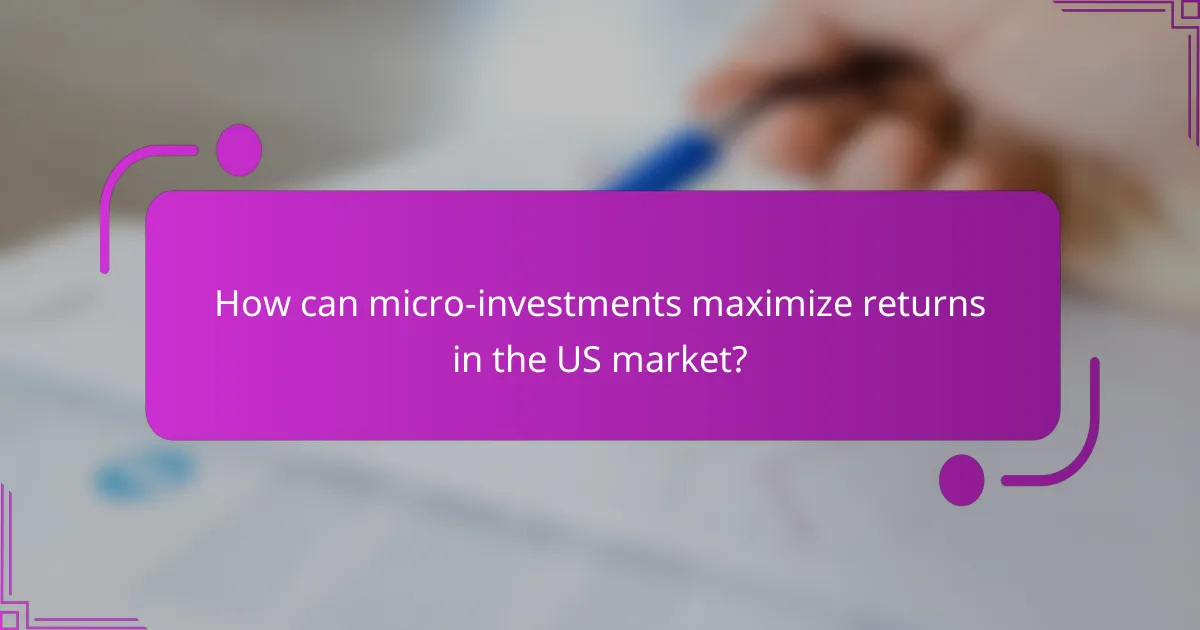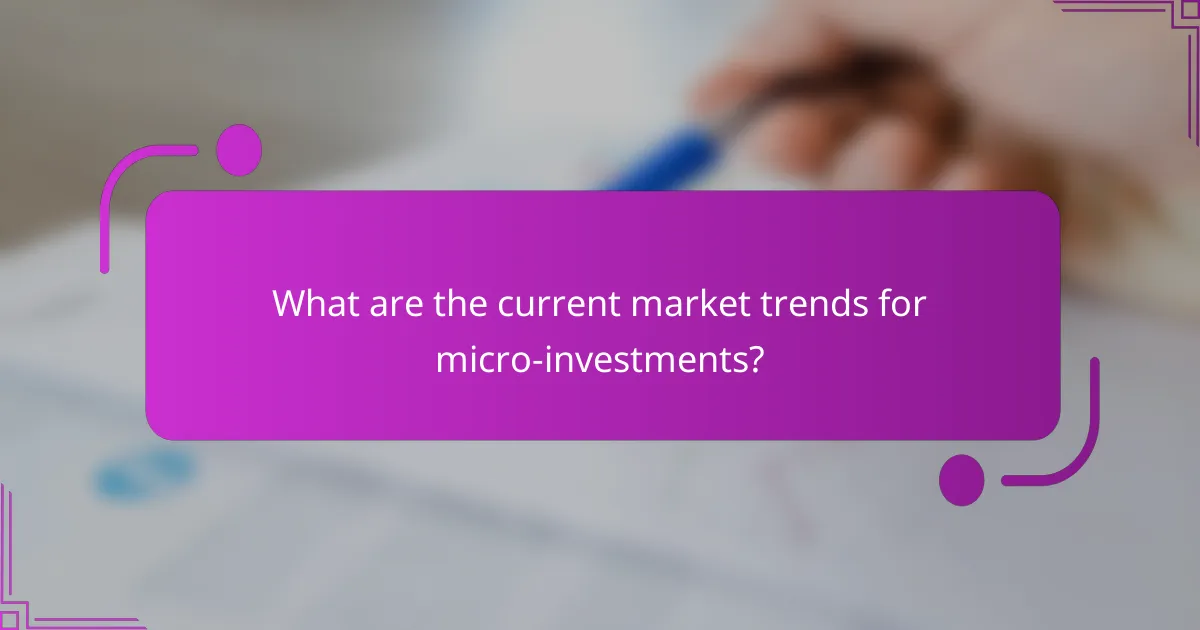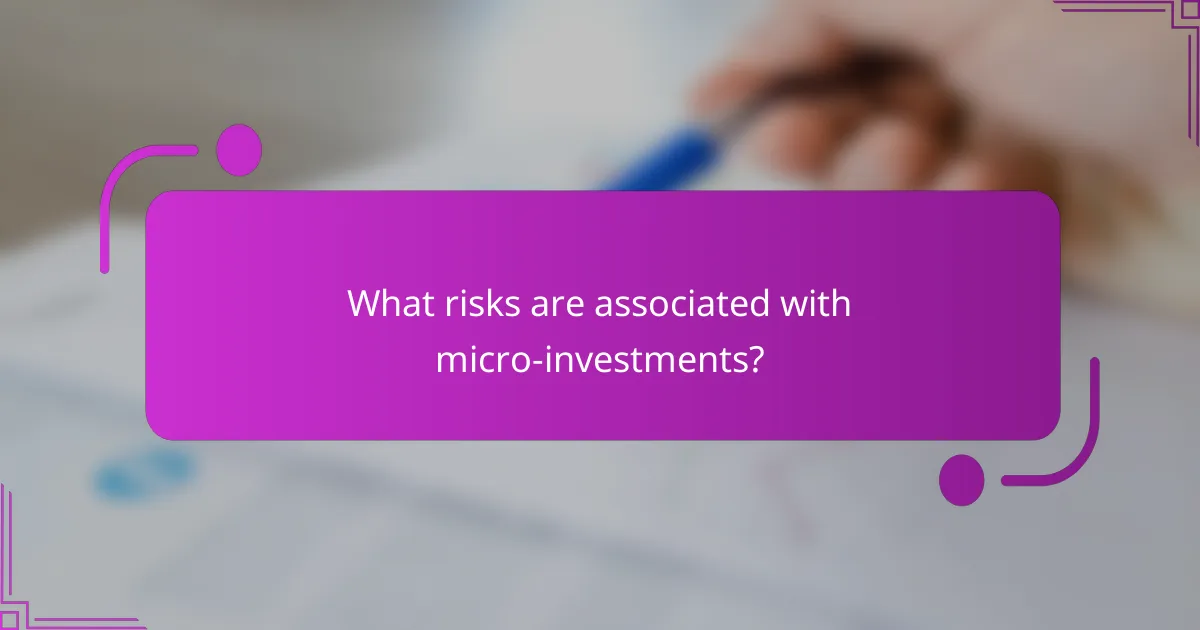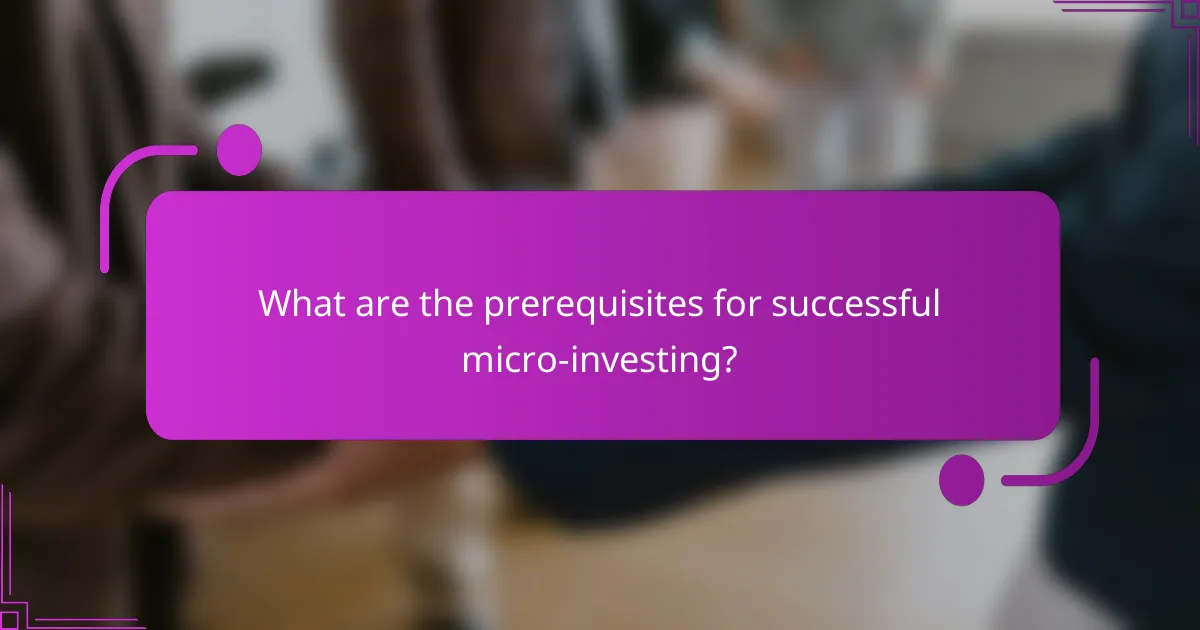Micro-investments offer a unique opportunity for investors to enhance their returns by allocating small amounts of capital into a diverse range of assets. This strategy not only mitigates risk but also provides access to high-growth opportunities that may be out of reach for traditional investors. By leveraging innovative platforms and technology, individuals can maximize their potential gains while effectively managing their investment risks.

How can micro-investments maximize returns in the US market?
Micro-investments can significantly enhance returns in the US market by allowing investors to allocate small amounts of capital into diverse assets. This approach not only spreads risk but also opens doors to high-growth opportunities that might otherwise be inaccessible.
High potential for diversification
Micro-investments enable investors to diversify their portfolios by spreading small amounts of money across various asset classes, such as stocks, bonds, and real estate. This diversification reduces the impact of poor performance from any single investment, thereby stabilizing overall returns.
For example, instead of investing a large sum in one stock, an investor could allocate $10 to ten different companies. This strategy minimizes risk while maximizing exposure to potential growth across multiple sectors.
Access to high-growth startups
Micro-investments provide access to high-growth startups that typically require larger capital commitments. Platforms that facilitate micro-investing often allow individuals to invest in early-stage companies, which can yield substantial returns if the startups succeed.
Investing in startups through micro-investments can be done with amounts as low as $100, making it feasible for many investors. This access democratizes investment opportunities that were once limited to venture capitalists and wealthy individuals.
Lower entry barriers for investors
Micro-investments lower the entry barriers for investors by allowing participation with minimal capital. This inclusivity encourages a broader range of individuals to engage in investing, fostering financial literacy and investment habits among new investors.
Many micro-investing platforms have no minimum investment requirements or charge low fees, making it easier for individuals to start investing. This approach empowers users to build their portfolios gradually without the pressure of significant upfront costs.

What strategies enhance micro-investment returns?
To enhance micro-investment returns, consider leveraging technology and innovative platforms that allow for small-scale investments. Strategies such as using robo-advisors, investing in fractional shares, and participating in crowdfunding can maximize your potential gains while managing risk effectively.
Utilizing robo-advisors like Betterment
Robo-advisors like Betterment automate investment management, making it easier for individuals to invest small amounts. They typically use algorithms to create diversified portfolios based on your risk tolerance and financial goals.
These platforms often require low minimum investments, sometimes as little as $10, and charge lower fees compared to traditional financial advisors. However, it’s essential to review their fee structures and investment strategies to ensure they align with your objectives.
Investing in fractional shares through platforms like Robinhood
Fractional shares allow investors to buy a portion of a stock rather than a whole share, making high-value stocks more accessible. Platforms like Robinhood enable users to invest with as little as $1, which can significantly diversify a small investment portfolio.
When investing in fractional shares, consider the overall market trends and individual stock performance. Be cautious of trading fees and ensure that the platform you choose offers a user-friendly experience and reliable customer support.
Participating in crowdfunding via Kickstarter
Crowdfunding platforms like Kickstarter allow individuals to invest in new projects or startups, often in exchange for early access to products or equity. This method can yield high returns if the project succeeds, but it also carries significant risks as many startups fail.
Before investing in a crowdfunding project, thoroughly research the business model and the team behind it. Diversifying across multiple projects can help mitigate risks associated with individual investments.

What are the current market trends for micro-investments?
Current market trends for micro-investments highlight a shift towards accessible and diversified investment opportunities. Investors are increasingly leveraging technology to engage in micro-investing, focusing on small amounts that can yield significant returns over time.
Increased popularity of mobile investment apps
Mobile investment apps have surged in popularity, allowing users to invest small amounts directly from their smartphones. These platforms often feature user-friendly interfaces and gamified experiences that attract younger investors. Examples include apps that allow users to round up purchases and invest the spare change.
Investors should consider the fees associated with these apps, as they can vary significantly. Some platforms offer commission-free trading, while others may charge monthly fees or take a percentage of profits.
Growth in ESG-focused micro-investing
Environmental, Social, and Governance (ESG) criteria are becoming central to micro-investing strategies. Many investors are now looking to support companies that align with their values, such as those focused on sustainability or social impact. This trend is evident in platforms that allow users to invest in ESG-compliant funds with minimal amounts.
When considering ESG-focused micro-investments, investors should research the underlying assets and their impact. It’s essential to verify that the funds genuinely adhere to ESG principles, as some may only superficially market themselves as such.
Rise of peer-to-peer lending platforms
Peer-to-peer (P2P) lending platforms are gaining traction as an alternative micro-investment avenue. These platforms connect individual lenders with borrowers, allowing investors to fund loans in small increments. This model can offer higher returns compared to traditional savings accounts, although it comes with increased risk.
Investors should assess the creditworthiness of borrowers and diversify their loans across multiple projects to mitigate risk. It’s advisable to start with smaller amounts to gauge the platform’s reliability and the performance of the loans before committing larger sums.

What risks are associated with micro-investments?
Micro-investments come with several risks that investors should be aware of, including market volatility, liquidity issues, and potential regulatory challenges. Understanding these risks can help investors make informed decisions and manage their portfolios effectively.
Market volatility and liquidity concerns
Market volatility can significantly impact micro-investments, as smaller companies or assets may experience larger price swings compared to established investments. This volatility can lead to rapid changes in value, making it crucial for investors to be prepared for potential losses.
Liquidity is another concern, as micro-investments may not be easily tradable. Investors might find it challenging to sell their positions quickly without affecting the market price, which can be problematic if immediate cash is needed.
Potential for lower returns compared to traditional investments
Micro-investments often yield lower returns than traditional investments, primarily due to their higher risk profile and the nature of the assets involved. While some micro-investments can outperform, many may not generate significant profits, especially in the short term.
Investors should set realistic expectations regarding returns. Aiming for modest growth rather than high returns can help mitigate disappointment and encourage a more sustainable investment strategy.
Regulatory risks in crowdfunding
Regulatory risks are particularly relevant in the micro-investment space, especially with crowdfunding platforms. These platforms may operate under different regulations depending on the country, which can affect the security and legality of investments.
Investors should familiarize themselves with local regulations governing micro-investments and crowdfunding. Understanding these rules can help avoid potential legal issues and ensure compliance with investment practices.

How to choose the right micro-investment platform?
Choosing the right micro-investment platform involves evaluating various factors such as fees, user experience, and available investment options. A well-suited platform should align with your financial goals and provide a seamless investing experience.
Evaluating fees and commissions
When selecting a micro-investment platform, carefully assess the fees and commissions associated with transactions. Look for platforms that offer low or no fees for small investments, as high costs can significantly erode your returns over time.
Common fee structures include flat fees per transaction, percentage-based fees on investments, or monthly subscription fees. Aim for platforms that provide transparency in their fee schedules, allowing you to calculate potential costs easily.
Assessing user experience and features
A user-friendly interface is crucial for a positive investing experience. Check if the platform offers intuitive navigation, educational resources, and customer support options to assist you when needed.
Additionally, consider features such as automated investing, goal tracking, and mobile accessibility. Platforms that provide these functionalities can enhance your overall investment journey and help you stay engaged with your financial goals.
Comparing investment options available
Different micro-investment platforms offer varying investment options, from stocks and ETFs to bonds and real estate. Review the types of assets available to ensure they align with your investment strategy and risk tolerance.
Some platforms may focus on specific sectors or asset classes, while others provide a broader range of choices. Make sure to compare the diversity of investment options, as a wider selection can help you build a more balanced portfolio.

What are the prerequisites for successful micro-investing?
Successful micro-investing requires a clear understanding of personal financial goals, a well-defined budget, and thorough research of investment opportunities. These elements help ensure that your small investments align with your overall financial strategy and risk tolerance.
Understanding personal financial goals
Identifying your personal financial goals is crucial for effective micro-investing. Consider what you want to achieve, whether it’s saving for a vacation, building an emergency fund, or investing for retirement. Each goal will influence your investment choices and timelines.
Set specific, measurable, achievable, relevant, and time-bound (SMART) objectives. For instance, if your goal is to save $1,000 for a vacation in a year, you can determine how much to invest monthly to reach that target.
Establishing a budget for investments
Creating a budget for your investments helps you manage your finances and avoid overspending. Start by assessing your income and expenses to determine how much you can allocate to micro-investments each month. Aim to invest a small percentage of your disposable income, typically around 5-10%.
Be mindful of your overall financial situation. Ensure that your essential expenses and savings goals are prioritized before committing funds to micro-investing. This approach minimizes financial strain and maintains a balanced financial plan.
Researching investment opportunities
Thorough research is essential to identify suitable micro-investment opportunities. Look for platforms that offer fractional shares, ETFs, or micro-investment apps that align with your financial goals. Evaluate their fees, performance history, and user reviews to gauge their reliability.
Consider diversifying your investments across different sectors or asset classes to spread risk. For example, you might allocate funds to technology stocks, sustainable energy, or real estate crowdfunding. This diversification can enhance your potential returns while mitigating losses.



